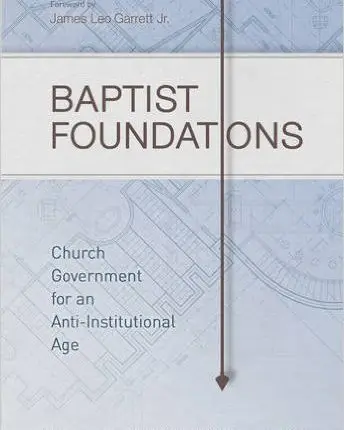Mark Dever and Jonathan Leeman have edited a new ecclesiology volume titled Baptist Foundations: Church Government for an Anti-Institutional Age. This collection of interrelated chapters is intended to be a “distinctly Baptist volume good for seminarians, church leaders, and interested members” (xxi). They have assembled a solid list of contributors, representing three of the major baptist seminaries in America. Below, I will briefly summarize and assess each author’s contributions and then conclude with an overall evaluation.
Part 1 includes a chapter on the historical roots of congregationalism (by Michael Haykin, SBTS) and a chapter outlining the biblical and theological case for congregationalism (by Kirk and Stephen Wellum, Toronto Baptist and SBTS, respectively). Haykin’s chapter was my favorite in the volume. He examined the congregational thought of an early French reformer named Jean Morely and his work A Treatise on Christian Discipline and Polity (1562). Then Haykin discussed the congregationalist legacy of the Separatists in the English Reformation, highlighting the work of Robert Browne, John Greenwood, Henry Barrow, and John Penry. Then he included a discussion of the religious liberty found in Oliver Cromwell’s thought, a liberty that “proved fertile ground for the development of congregationalism” (35). Followed by a discussion of John Owen, as well as particular baptists John Spilsbury, William Kiffin, Samuel Richardson, and Benjamin Keach, Haykin traces congregational thought through the First London Baptist Confession. He concludes with a brief discussion of the role of church covenants in congregationalism. Haykin’s chapter appears, unlike most of the other chapters, to be written fresh for this volume. His discussion of the roots of early reformation era congregationalism was fascinating (e.g., Morely’s interaction with Calvin & Beza, 28), as well as a connecting the discussion of liberty of conscience with congregational polity under Cromwell. For the historically-minded, this chapter will not disappoint.
Chapter 2 by the Wellums includes a basic summary of a theology of the church. They affirm that the church is “under the lordship of Christ and under the authority of divinely given elders who lead, [and that] the last and final court of appeal in matters related to the local church is the congregation itself” (49). They emphasize that there is only “one elect people of God throughout time” (51, contra dispensationalism), that the church as the new covenant community really is new (52), that the new covenant church is God’s eschatological assembly (56), that the new covenant community is God’s new temple (59), and that the new covenant community is God’s new humanity (60). From these arguments about the church’s nature (ontology), their discussion moves to how the church should function (methodology, i.e., congregationalism). Here they defend from the New Testament each aspect of their definition above: Christ rules the church, elders lead the church, the congregation is the final court of appeal in the church. This chapter was a good summary of standard congregational affirmations. Not much, however, was said in this chapter that hasn’t already been said by the authors in other places (e.g., Stephen Wellum, “Beyond Mere Ecclesiology: The Church as God’s New Covenant Community,” in The Community of Jesus, ed. K. H. Easley and C. W. Morgan (B&H, 2013).
Part 2 contains 5 chapters on the ordinances written by Thomas Schreiner and Shawn Wright (both professors at SBTS). Schreiner’s chapters on baptism and the Lord’s supper in the Bible were good introductions to the exegetical basics of sacramental theology. He ably addresses several common paedobaptist arguments (e.g., Jesus’s call for the children in Matt 19:14, pg. 93; household baptisms, pg. 97) as well as some theological relationships (e.g., baptism and union with christ, pg. 99; baptism and regeneration, pg. 102; Is Jesus speaking of Communion in John 6?, pg. 136). Likewise, Wright’s chapters show his thorough historical understanding of the paedobapist/credobaptist debates. He spends almost ten pages examining and interaction with the covenantal paedobaptist position (112ff.), he discusses the mode, subjects, and meaning of baptism, and he connects baptism to the gospel and church membership. Wright also gives a good historical survey of the positions on the Lord’s supper held since the reformation. His survey includes a brief summary of the intra-baptist debates over open/close/closed communion (152). Schreiner and Wright were given the tough task of discussing the biblical, theological, and historical issues surrounding both ordinances. Their chapters were great introductions to the issues surrounding the debates; although, I do wish that they had included a discussion of the historical covenantal credobaptist positions and arguments used against paedobaptists (e.g., Nehemiah Coxe or the 2nd London Baptist Confession).
Part 3 includes chapters by John Hammett (SEBTS) and Thomas White (formerly SWBTS, now President of Cedarville) on church membership and discipline. Hammett’s first chapter argues that “the call to church membership for Christians is still strong and persuasive, with a basis in scripture, history, theology, and christian practice” (168). He then proceeds to show how the NT calls for church membership both explicitly (“the call to salvation is a call to church membership,” 169) and implicitly (e.g., the “one another” commands, 169). He includes a section discussion the importance of regenerate church membership which details the rise of infant baptism in church history (174). He concludes by arguing that there are three requirements for church membership: salvation (173–76), baptism (176), and some type of covenantal commitment (177f.). Hammett’s second chapter discusses the “what” and “how” of church membership. Specifically, this chapter details the responsibilities and benefits of membership for individuals, leaders, and the entire body. He then closes with a list of suggestions for how churches can practice meaningful membership (e.g., teach and emphasize the importance of meaningful membership, develop a church covenant, practice redemptive church discipline). Hammett’s contributions to this volume, while solid and helpful, seemed to be summaries of what he has argued at length elsewhere (see his Biblical Foundations for Baptist Churches, which is excellent). One exception is his discussion of when it is advisable to leave a church (196f.). He offers some wise counsel to those who are struggling through that tough decision.
Thomas White’s chapter is on “The Why, How and When of Church Discipline.” The “why” he explains by showing that the NT prescribes both formative and corrective church discipline. Both of these aspects of church discipline are discussed under the “how” section. He explains the goal of church discipline (restoration), the attitude (gentleness/love), and also explains how the process is slightly different with disciplining church leaders. He describes the historical decline in the practice of church discipline and concludes with some suggestions for seeing the practice restored in our churches. White’s chapter surveys the NT texts that speak to church discipline (e.g., Matt 18, 1 Cor 5), addresses many practical concerns, and offers wise counsel for the implementation of discipline. Furthermore, his footnotes helpfully steer the reader to the some of the best recent works on what can be a contentious issue.
Part 4 is devoted to discussing elders and deacons and was tasked to Mark Dever (Capital Hill Baptist, SEBTS), Benjamin Merkle (SEBTS), and Andy Davis (FBC Durham, SEBTS). Dever’s chapter seeks to argue that elders belong to baptist history, and thus to baptist churches today (229). Spending most of his time focusing on the history of the office of elder, Dever really zeros in on the early baptists. Surveying the though of Keach, Griffith, the Charleston Association, W. B. Johnson (first president of the SBC), J. L. Reynolds, William Williams (founding SBTS faculty member), Spurgeon, and others, Dever shows that elders have a solid place in the history of baptists. Finally, Dever speculates about some of the reasons why we are seeing a renewed interest in plurality of elders in baptist life. He proposes some reasons that are unrelated to SBC life (e.g., John MacArthur’s advocacy of plurality, several systematic theologies that advocate plurality: Erickson, Berkhof, Grudem) and some factors related to SBC life (e.g., interdenominational conversation, interest in baptist history, renewal of inerrancy). This chapter was a fairly thorough defense of the prominence of elders in the history of baptists. While I wish he had said more about the role of deacons in baptist life, this was a helpful survey with some fascinating reflections.
Next, Benjamin Merkle gives three chapters on the biblical basis for, qualifications of, and role of elders in the life of the church. These are topics on which he has written extensively elsewhere (e.g., see his 40 Questions book), so he is well qualified to cover these areas. Of note are the examination of some controversial elder qualifications (264). He takes “husband of one wife” (1 Tim 3:2) to mean that an elder must be considered faithful to his present wife and not open to the charge of polygamy, promiscuity, or homosexuality (267). He also addresses tough questions about the salvation of an elder’s children (267–70). Merkle also defends the plurality of elders biblically and shows the practical benefits of having a plurality. His treatment of elders is both thorough and packed with practical wisdom. These chapters were a helpful distillation of his sustained attention to polity found in several other volumes (that can be found in the footnotes).
Andy Davis wrote two chapters on the practical issues of elder and deacon ministry. These address issues ranging from the role of elders in church planting/revitalization, elders and congregational polity, and elders and discipline, to selecting and installing deacons and distinguishing between the office of elder and deacon. Davis’ years of pastoral experience shine through as he shows the wisdom of the elder/deacon structure in church life as well as showing how to avoid several pitfalls in elder/deacon ministry. These practical chapters would be beneficial for any present or future church officer to consider.
Finally, Part 5 was given to Jonathan Leeman (Capital Hill Baptist, SEBTS) and is devoted to discussing congregational understandings of apostolicity and catholicity. Leeman’s argument in his apostolicity chapter is that “apostolic doctrine unites all Christians and all churches, but a local church is united by both apostolic doctrine and apostolic office” (335). He emphasizes that the universal church is united by a new covenant unity created by apostolic doctrine. However, he adds that local churches are united “as more than members of the new covenant. They are united through the ordinances by their shared affirmation of one another as holy, or by… [what he calls] the apostolic office” (335). He then surveys conceptions of the relationship between holiness and apostolic authority throughout church history. He hits several major players in the debate (e.g., Tertullian, Cyprian, Augustine, Calvin), discusses the relationship between apostolicity and the “keys of the kingdom” (353; an idea he’s written upon elsewhere), and concludes by connecting apostolicity, holiness, and unity. In sum, he argues that “Apostolic doctrine unites Christians and churches. Apostolic doctrine and apostolic office unites a church” (367).
His final chapter is an exploration of the implications of his previous chapter on apostolicity and unity. He argues that “the fact that the authority of the apostolic office belongs to the local church alone means churches are formally independent and christians must be united to local churches” (367). Churches are independent, but should also be interdependent. He digs into various practical implications (more than 25!) of these assertions and shows how the NT should inform intra-church connections. Leeman’s winsome and engaging writing makes his solid logic and strong argumentation even more compelling. I love this push for simultaneous independence and interdependence. This is a great way to finish a volume that could otherwise be seen as promoting an isolationist polity.
Overall, this volume is a great introduction to congregational thought. It places the polity debate historically, grounds it exegetically, relates it theologically, and applies it practically. Perhaps this volume is even more helpful in that it serves as an introduction to the tough issues involved in the polity debate and points readers to more in-depth treatments of each specific topic (the footnotes are great!). While there were a few issues I with they had addressed (mentioned above), I do think this is the best recent introductory work on congregational polity.



